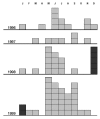Wind in November, Q fever in December
- PMID: 15324547
- PMCID: PMC3323349
- DOI: 10.3201/eid1007.030724
Wind in November, Q fever in December
Abstract
Q fever, a worldwide zoonosis caused by Coxiella burnetii, can be transmitted from animal reservoirs to humans by the inhalation of infected aerosols. We investigated the epidemiology of Q fever in the Bouches-du-Rhone district of southern France, particularly the role of wind and rainfall in C. burnetii transmission. During the winter of 1998 to 1999, an unexpected number of cases were diagnosed in the area. This statistically higher incidence was associated with an increased frequency of the mistral 1 month before onset of disease, i.e., shortly after the main lambing season. These data confirm that wind plays a role in C. burnetii transmission, a factor that can be monitored but not prevented. Further studies are needed to identify and confirm preventable individual behavioral risk factors for Q fever.
Figures





Similar articles
-
Hyperendemic focus of Q fever related to sheep and wind.Am J Epidemiol. 1999 Jul 1;150(1):67-74. doi: 10.1093/oxfordjournals.aje.a009920. Am J Epidemiol. 1999. PMID: 10400556
-
Airborne geographical dispersal of Q fever from livestock holdings to human communities: a systematic review and critical appraisal of evidence.BMC Infect Dis. 2018 May 15;18(1):218. doi: 10.1186/s12879-018-3135-4. BMC Infect Dis. 2018. PMID: 29764368 Free PMC article.
-
Q fever outbreak in homeless shelter.Emerg Infect Dis. 2004 Jul;10(7):1297-9. doi: 10.3201/eid1007.031020. Emerg Infect Dis. 2004. PMID: 15324553 Free PMC article.
-
A pedagogical farm as a source of Q fever in a French city.Eur J Epidemiol. 2005;20(11):957-61. doi: 10.1007/s10654-005-2336-5. Eur J Epidemiol. 2005. PMID: 16284874
-
Coxiella burnetii infections in sheep or goats: an opinionated review.Vet Microbiol. 2015 Dec 14;181(1-2):119-29. doi: 10.1016/j.vetmic.2015.07.011. Epub 2015 Jul 15. Vet Microbiol. 2015. PMID: 26315774 Review.
Cited by
-
Spread of Coxiella burnetii between dairy cattle herds in an enzootic region: modelling contributions of airborne transmission and trade.Vet Res. 2016 Apr 5;47:48. doi: 10.1186/s13567-016-0330-4. Vet Res. 2016. PMID: 27048416 Free PMC article.
-
Acute Q fever in northern Queensland: variation in incidence related to rainfall and geographical location.Epidemiol Infect. 2013 May;141(5):1034-8. doi: 10.1017/S0950268812001495. Epub 2012 Aug 13. Epidemiol Infect. 2013. PMID: 22882795 Free PMC article.
-
Molecular typing of Coxiella burnetii from animal and environmental matrices during Q fever epidemics in the Netherlands.BMC Vet Res. 2012 Sep 18;8:165. doi: 10.1186/1746-6148-8-165. BMC Vet Res. 2012. PMID: 22988998 Free PMC article.
-
Molecular method for the characterization of Coxiella burnetii from clinical and environmental samples: variability of genotypes in Spain.BMC Microbiol. 2012 Jun 1;12:91. doi: 10.1186/1471-2180-12-91. BMC Microbiol. 2012. PMID: 22656068 Free PMC article.
-
Coxiella burnetii infection persistence in a goat herd during seven kidding seasons after an outbreak of abortions: the effect of vaccination.Appl Environ Microbiol. 2024 Mar 20;90(3):e0220123. doi: 10.1128/aem.02201-23. Epub 2024 Feb 27. Appl Environ Microbiol. 2024. PMID: 38412030 Free PMC article.
References
MeSH terms
LinkOut - more resources
Full Text Sources
